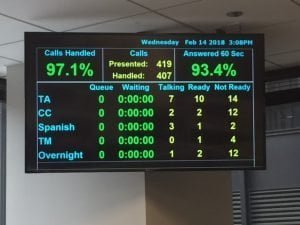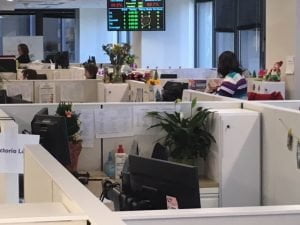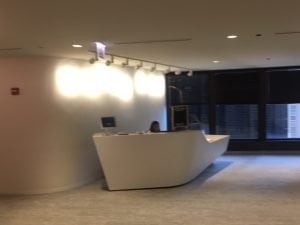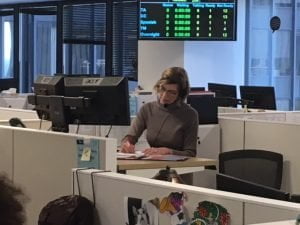Better Than Most is a regular feature of The Business of Giving, examining the best places to work among social good businesses and nonprofit organizations.

Denver: So this week, you’ll be heading out to Chicago, Illinois in the new offices of the Alzheimer’s Association, a perennial on the Best Places to Work list. We’ll begin with Harry Johns, their president and CEO, and then hear from some of the other members of their staff.
Harry: I think what makes our culture great is our people. We try at the outset to bring people to the organization, to bring in people who are going to make a difference in other people’s lives but not just the ones outside; the ones inside the organization, too. Because when all these people can work together on that common cause in a way that makes a difference with them every day, make an even bigger difference for the people we are working for who are our constituents.
Laura: Our president and CEO, Harry Johns, conducts what we call town halls here at the home office, and they’re not only for home office staff. They’re also for all of our 78-plus chapters across the country. So, they’re invited to tune in, and he addresses all of the staff members with any current updates. He brings on our task force to give us updates as well. But then he does… he opens it up to the floor, and he takes questions from the field; whether they be thick in the weeds where he might have to pass it over to another team member or high-level questions. So, it’s been really encouraging, as we’re going through so many changes these past couple of years and growth, knowing exactly what’s going on and having an eye to what’s happening.
Nicole: I would like to talk about the vibe of the office, and how positive everyone is. I remember when I first started. Right in my interview process, one of the questions they asked me is about my self-care routine. I have never been asked that ever in my life. I remember just being surprised and then I just felt very open with the people that I was speaking with. And it created… it made me so much more comfortable, and I love that atmosphere immediately when I started. So a lot of people especially I would say in the contact center that worked through helpline, they come from counseling, therapy, social work backgrounds, and they really care. We care about the work we do here but also we care about each other, and that’s palpable, and it fosters I think additional positivity. And it really creates this culture of helping others. I mean, we even email each other self-care tips.
Samantha: So, everyone is so supportive of each other and encouraging. There’s this feel when you walk into the office that you have friends there. People aren’t against each other. Everyone’s promoting each other, encouraging each other like Nicole said. There are emails going out about things that people have accomplished or when we get feedback from callers, the positive remarks that are received. So, overall, it’s an environment where there’s just a lot compassion for the people that we work with but also for each other. I think it really shines through and people who are new here really point that out. They’ll be like, “Wow, I’ve never worked in an environment like this”, and it’s true. We’re all working towards the same goal to help those who are affected by this disease, and I just think that it’s a great place.
Nicole: One of the things that I’ve always loved about working for the Alzheimer’s Association is that I’ve never forgotten while I was here and part of being able to do that through employee engagement, one of the things they used to do was called the mission moment. We used to have our leadership conferences, and we would have someone who was diagnosed who would come and talk with us. It was always a reminder of my day-to-day tasks meant something.
Dee: With my experience being here, I’ve always treated everyone as though they were a customer. And I get the same feedback from all the other employees; we treat each other as though we are like a customer, and we give them great customer service at a high professional level. So, I think working for the association as a team, we as a team working here, we give that customer service to not only our constituents but to each other which make the environment or the team effort even better as we work together.
Ulick: I’m not sure if this with other organizations but certainly with on the operations, and I work in Legal. So, we’re in operations, we do a customer service survey to all the departments that we work with. Research or conference services or programs, HR, and they grade us on how we’ve been doing. I came from a private law firm, and I’m working here, and I try to think of everyone as a client. That they’re a client of our little firm in the association. That works very well and I know we’ve gotten good feedback from that but the professionalism that I’ve encountered dealing with all the different departments, I find to be such a high level. Everyone really knows what they’re doing.
Monica: As a result, in the almost 14 years that I’ve been here, I’ve had the opportunity to start in the contact center. I led our safety services area, went into corporate initiatives where I didn’t know anything about reaching out to businesses and having them support us as an organization but it so happens that my long-term care background was perfect for reaching out to the long-care industry. Who knew that that was going to be an area that I could really excel at? From there, I went back into the programs area. So, when I look back at my career over the almost 14 years, it really has given me an opportunity to grow professionally and personally, and I’m doing things that I never would have thought I could do when I was in social work school. I thought all I could do was be a social worker and help families who are in crisis. And I am still doing that but in a much different way, and I think in a greater impact, I’m able to make with this organization.
 Keith: Speaking of the mission symbol, the mission symbol, people may not understand what it is because it’s somewhat abstract but it represents a human head on one side and a science beaker, really a Florence flask, on the other side. That’s the two sides of our mission; helping people who are affected by the disease today, both those who have it and the people who care about them and are also affected. Also then getting to the end of this disease through science and research, so that we don’t have to continue that first part of the mission and we can someday get to the end of this and Alzheimer’s disease will be a distant memory the polio is now. I think the great strength of our organization is that we do have both sides of that mission. I think it’s fairly unique to us and is empowering to us that each of knows, regardless of which side that we’re working on, each of us knows the importance of the other side as well, and we feel pride in both our side and the other side.
Keith: Speaking of the mission symbol, the mission symbol, people may not understand what it is because it’s somewhat abstract but it represents a human head on one side and a science beaker, really a Florence flask, on the other side. That’s the two sides of our mission; helping people who are affected by the disease today, both those who have it and the people who care about them and are also affected. Also then getting to the end of this disease through science and research, so that we don’t have to continue that first part of the mission and we can someday get to the end of this and Alzheimer’s disease will be a distant memory the polio is now. I think the great strength of our organization is that we do have both sides of that mission. I think it’s fairly unique to us and is empowering to us that each of knows, regardless of which side that we’re working on, each of us knows the importance of the other side as well, and we feel pride in both our side and the other side.
Samantha: I’ve been here about two and a half years, and within the first year that I was here, I had recommended three of my fellow social workers to work here. And they still work here. Honestly, I didn’t really even consciously recommend them. I think it’s just that I always talking so positively about my work, and people started asking me more about the position. I feel like I didn’t even have to work hard to get them to come here. They wanted to because they saw just the change that I experienced coming here; with the work-life balance, the relationships I’ve built.
Mike: One of the things that I really love about our new office space is the wide open places, more areas for people to really sit together and brainstorm or work together and one of the health-conscious additions to the new office space is standing work desk for everybody. Not everybody uses them but typical day when you walk around from time to time, usually you’ll see a healthy group of people standing at their desks, working at their workspace, and I think we’re all more conscious of the fact that sitting for eight hours is not a good thing. The association recognized that and built that into the new workspace.
Berisa: With our new office space, we also have a lot of team rooms which we encourage departments and teams together for a quick huddle up to exchange some ideas. Also give some feedback, some suggestions and also these team rooms, our technology has become a lot better where it makes it a little easier to communicate with our chapter offices throughout the United States. So, even though we are far away, we are still very close, and it is very easy to meet our team members that are not here and also share some ideas and collaborate.
Keith: So, I got to meet a lot of people here which is good, and they got to meet me. So I think there was a feeling; you get a chance to feel each other out and see what’s going to be a good fit. Then when I was fortunate enough to be made the offer and decided to accept it, about a week before I actually arrived for my first day, I got in the mail this great big greeting card that had welcome on it, handwritten in huge, big loopy letters, and then everyone from the Med Sci team had signed it as well. So, that really made me feel welcomed with open arms and actually part of the team before I even got here.
Nicole: I just wanted to add on about the renovation. I think first, the best part about the renovation process is that we were all actually included in the process. We got to submit our feedback, our ideas, and they were actually used. We talked about the standing desks and the meeting areas but in the contact center, there’s also relaxation rooms, and there are spaces where people can do yoga, meditate, listen to music. It’s not just one common break room. People had voiced that they wanted an area where they can just close their eyes and have some quiet time or do some exercises, and we have that now. And I think when people walk in, yes you see the beautiful space but there’s so much behind the scenes that focuses on self-care and those rooms are just huge addition to the work that we do here.
Harry: I think, in my 12 years here, we’ve certainly tried to focus on bringing in people who care deeply about what we’re doing. Other causes can certainly have that too. But we also then try to make an environment that is really good for those people who are helping others.

Denver: I want to thank all those who participated in this piece: Harry Johns, Mike Lynch, Ulick O’Sullivan, Monica Marino, Samantha Lendzion, Laura Putman, Berisa Adilovic, Nicole Ortiz, Keith Fargo, Nicole Sanders, and Dee Harris. To listen to this again, read the transcript, or see pictures of the participants and the offices of the Alzheimer’s Association, they’re all there waiting for you at denver-frederick.com.
The Business of Giving can be heard every Sunday evening between 6:00 p.m. and 7:00 p.m. Eastern on AM 970 The Answer in New York and on iHeartRadio. You can follow us @bizofgive on Twitter, @bizofgive on Instagram and at http://www.facebook.com/BusinessOfGiving







